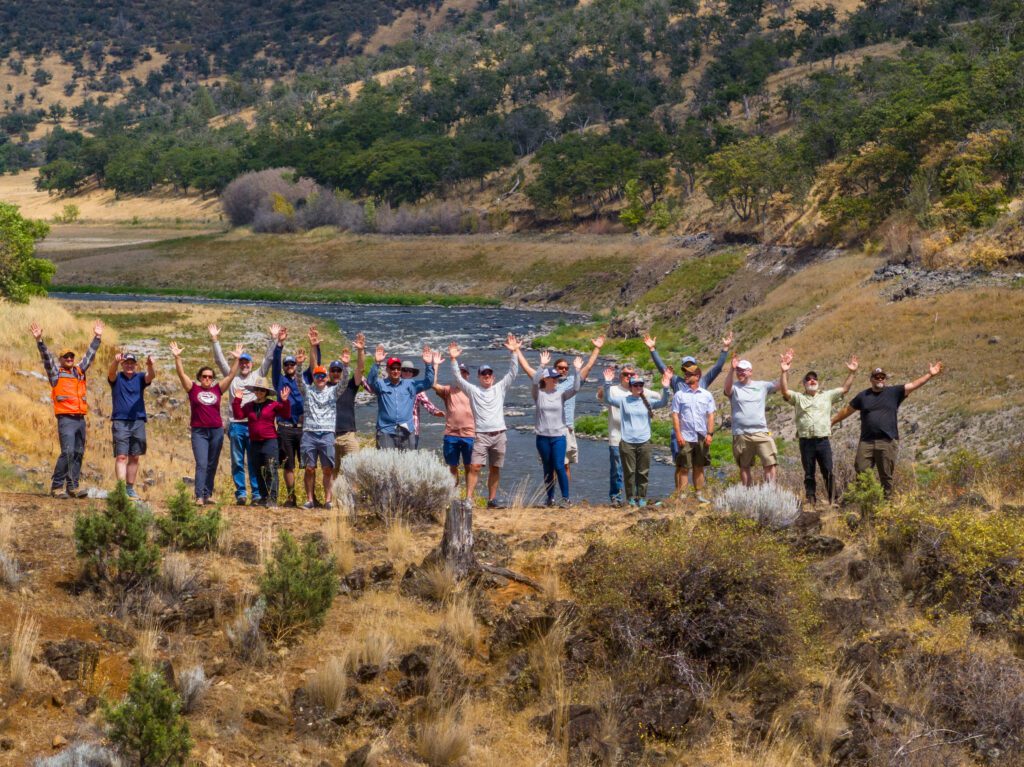
In July 2024, CalTrout and partners launched the Klamath River Monitoring Program to build our understanding of dam removal including how fish repopulate newly opened habitat and how they recover from landscape level restoration. Pictured above, the members of the Klamath River Monitoring Project. Photo Courtesy Pusher Media / California Trout.
Humboldt Area Foundation + Wild Rivers Community Foundation has awarded a grant to the nonprofit California Trout to support its program to monitor fish migration and restoration efforts of the Klamath River following the removal of four dams, the largest such effort in history.
California Trout, in collaboration with nonprofits and government agencies, the Klamath Tribes (Klamath, Modoc, Yahooskin-Paiut), Karuk Tribe and Yurok Tribe, launched the Klamath River Monitoring Program in July. The program’s mission is to understand the benefits of dam removal including how fish repopulate newly opened habitats and how they respond to landscape level restoration.
Support from Humboldt Area and Wild Rivers Community Foundation catalyzed a 5x pledge from federal funding sources to launch a cutting-edge science and monitoring study.
Damon H. Goodman, the Klamath-Mt. Shasta Regional Director for CalTrout
The program is made possible through financial support from HAF+WRCF, Bella Vista Foundation, Bureau of Reclamation, NOAA Fisheries and U.S. Fish and Wildlife Service.
“Klamath Dam removal is unfolding in our backyards and is amongst the most inspirational actions in the world today. Support from Humboldt Area and Wild Rivers Community Foundation catalyzed a 5x pledge from federal funding sources to launch a cutting-edge science and monitoring study. This project puts the Karuk Tribe, Yurok Tribe and Klamath Tribes at the forefront to learn from the Klamath dam removals and set the stage for the next round of landscape-level restoration,” said Damon H. Goodman, the Klamath-Mt. Shasta Regional Director for California Trout.
By fall 2024, all four dams will be breached, creating a free-flowing river from Lake Euwana in Oregon to the sea for the first time in over a century. This will allow migrating salmon and steelhead to access over 400 miles of historical habitat. Project partners will monitor fish migration beyond the dam sites and assess the efficacy of the restoration effort. They hope to determine how many salmon and steelhead are moving into the newly accessible habitat, what species are returning, what time of year are they moving, and where they are going to spawn and rear.
The program will use SONAR imaging, netting, radio telemetry, and spawner surveys. SONAR imagery will provide a look into turbid waters to record movie-like imagery of passing fish on a continuous basis. Netting will document fish species assemblages, age, length and genetic information, and allow California Trout to attach tags to fish. Radio telemetry can help track fish migration into the 400 miles of newly re-opened habitat. While spawner surveys will provide information about their nesting locations. Together, these methods will reveal how fish are responding to dam removal and inform future restoration efforts in the Klamath and beyond.
“We were attracted to this project for not only what they are doing, but how they are doing it,” said Pimm Tripp-Allen, Vice President of Programs, Community Partnerships & Tribal Relations. “Collaboration is key to the project’s success, with the project team consisting of dedicated individuals from local Tribes and NGOs, along with state, and federal agencies. This is the kind of collective effort that is necessary not only to restore Klamath fisheries but foster healthy relationships between Klamath communities as well.”
For more information about California Trout, visit caltrout.org
